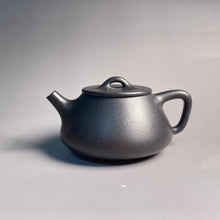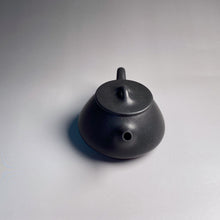
Capacity: Approximately 100ml
This "heini" or "black clay" Yixing teapot is produced by firing original ore jiangponi clay in a low oxygen environment in the kiln.
Firing a teapot in a low-oxygen environment is called “wuhui” 焐灰 which can be loosely translated as “smother with ash to fire.” The teapot is stuffed with dry rice straw, placed in a clay box and surrounded with more rice straw before being covered. When it is fired in this way, the straw uses the oxygen when it burns to ash, reducing the oxygen in the clay box while the teapot is being fired. This creates the reduced oxygen environment that gives the clay its black appearance.
You can read our blog entry here to learn more about the reaction that occurs in a reduction environment to give the clay this appearance in our blog post here.
Jiangponi 降坡泥 is a special Yixing clay (zisha) that comes from an original ore that is a combination of the purple (zini), yellow (duanni), and red (hongni) clay. The clay has a unique feel and color with specs of yellow and other colors visible on the skin. This variety of jiangponi is the more desirable variety also known as jiangpo hongni 降坡红泥, and was mined near Huanglong Mountain. Jiangpo hongni is classified as a type of hongni and will absorb less of the aroma/flavour than most zini but will round the flavour more than zhuni.
You can read more about jiangponi in our blog entry here.
This teapot shape is known as shipiao. This pot is known as "half-handmade" as the sculptor uses a molding tool to shape the body, and uses his hands for the handle, spout, holes, and smoothing out the body. In fact, no machine was used in it's shaping as the use of the tool is entirely manual.
You can read more about half handmade teapots in our blog entry here.
This teapot was made by Lin Hanpeng and Chen Chunhong Studio.
Preparation Before Use
Yixing Teapots should be prepared before using the first time. This is called "opening the pot". It removes the dust from firing the teapot.
We recommend rinsing the teapot under warm water two or three times, then filling the teapot with boiling water and emptying it out two to three times. After this the teapot is ready for use.

















